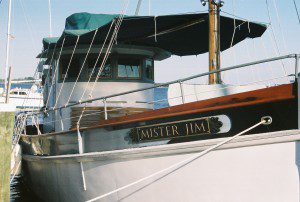 In the heart of downtown Piney Point on Rt. 249 is the machine shop owned by Joe Gardner. Should you need something fabricated, welded, brazed, machined, etched, threaded, bent, sheared, or cut, Joe can get the job done.
In the heart of downtown Piney Point on Rt. 249 is the machine shop owned by Joe Gardner. Should you need something fabricated, welded, brazed, machined, etched, threaded, bent, sheared, or cut, Joe can get the job done.
This October afternoon, he was cutting up some slabwood left over from a loblolly pine log that came from a right-of-way clearing job. He and his father cut the log into thick planks with Joe’s chainsaw sawmill. The planks will be ripped into short handles for a very specialized oyster tong.

Joe is building iron nipper claws that bolt to the end of these handles. The nipper tong is a very small double claw tool that was used for picking up a single oyster at a time.
Today, the water is generally too murky for nipper tongs to work very well and oysters are not abundant enough for them to be effective. The nipper tongs that Joe is building will most likely go on display on someone’s wall.
My only experience oyster tonging was with Wayne Suite on his big wooden charter boat formerly known as the Fishing Fun that he bought from Capt. Pete Ide.
We borrowed a couple big tongs and headed out to the oyster bars off Benedict the first day of oyster season.
With six people on board, we could recreationally harvest six bushels of oysters for the day. After working those tongs for a couple hours, we only had a half bushel to show for our efforts. That was the first and last time I ever tonged for oysters. Oyster diving is a far more effective way to gather oysters, but there is a catch.
Unfortunately, diving for oysters requires submerging your body into cold water. Those months with an “R” in them happen to be on the cool side of the calendar. Obviously, a wet suit is necessary.
A dry suit is better. True professional oyster divers rig up a hose that pumps heated water into their wet suits from the idling boat engine. With toasty warm water flowing through their suit, a working oyster diver can stay down for hours.
My dives on Patuxent River oyster bars have been educational but disappointing. Imagine a bottom covered with silted empty shells and minimum visibility. Every once in awhile a living oyster will be found but that is only one edible mollusk for hundreds of dead shells. That is the way things were in the Patuxent off Solomons Island twenty years ago. Today, the conditions are likely worse.
I enjoyed better diving for oysters in the Chesapeake Bay not far from the Calvert Cliffs Nuclear Power Plant. The water was generally much cleaner. Back then, there were clay lumps that were like big soft coral heads. Under the lumps and in holes within them, oysters grew fat in healthy groups. A clay lump could easily result in a full dive bag of oysters.
Also, I ran a single oyster dive charter out of Chesapeake Beach for Capt. Ken Pumphrey aboard his wooden lapstrake charter boat named Patches. There are good reasons why I only ran a single trip for Capt. Ken but I will save that story for another issue of the CHESAPEAKE.
Perhaps, the most unique oyster boat I ever saw was hitched up to a horse heading west on Rt. 236. John Fisher had built a pontoon boat out of blue plastic barrels mounted under a wooden deck.
He and a hearty group of fellow Amish men armed with oyster tongs launched the rig at the Wicomico Shores Public Landing. The wind was ripping pretty strong that day and the floating platform took off down the Wicomico River out of control.
They finally made shore at Chaptico Wharf. Of course, the horse was back at Wicomico Shores. A motor would have been nice but out of the question from the Elders’ point of view.
Sadly, the glory days of bountiful oyster reefs are, at present, a thing of the past. We can hope that the new oyster sanctuary regulations introduced by Governor O’Malley and the Maryland Department of Natural Resources will be part of a greater solution that helps our Bay and rivers return to the bountiful estuaries they once were.
We have witnessed the return of the rockfish, might the oysters be next?

